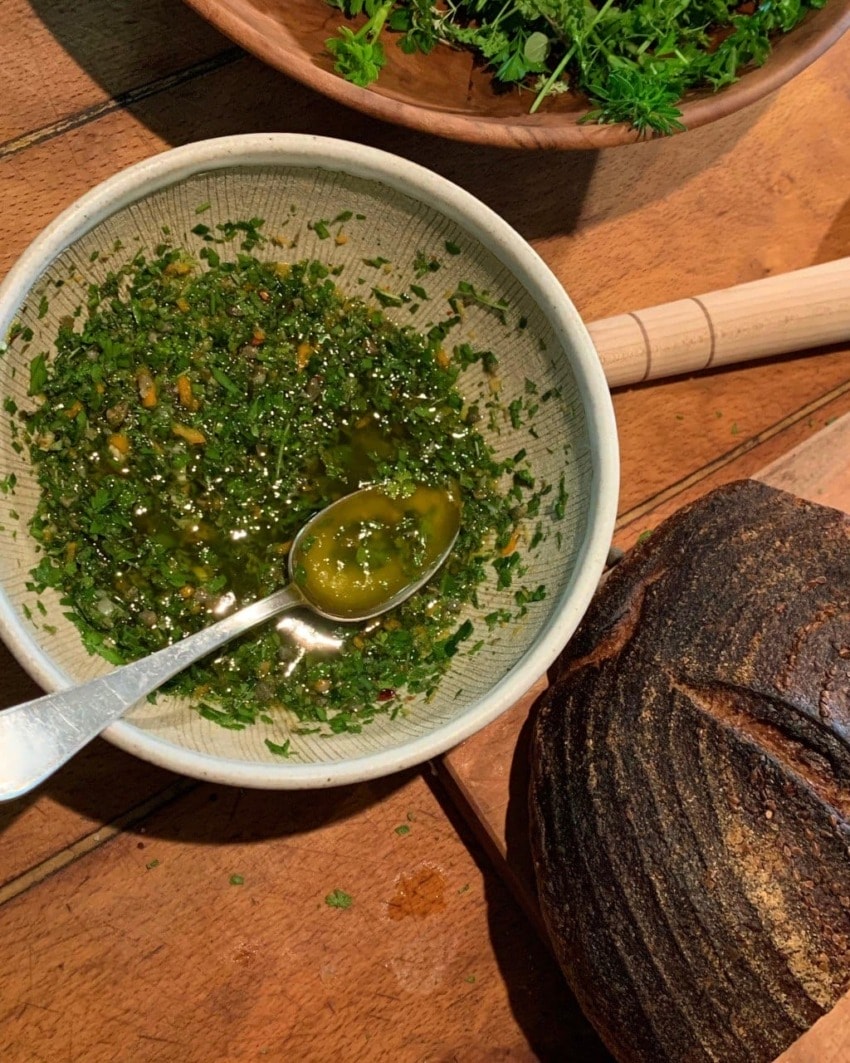Fanny Singer, Daughter of Alice Waters, Shares Her Famous Salsa Verde Recipe
The new book Always Home by Fanny Singer features this delicious condiment


Salsa Verde, also known among my friends as “manna from the heavens,” is one of the cornerstones of my cooking. I rarely go a week without making it. It’s also the thing that most routinely results in people telling me that I’m “an amazing cook,” even when all they’ve tasted up to that point is a bite of potato slathered in sauce. In fact, I believe this loose, herby concoction to be disproportionately responsible for any pleasure experienced at my table, which is why I almost always serve it at a dinner party, no matter the menu. If, God forbid, I could eat only one sauce for the rest of my days—and I’m shocked I’m even saying this—I’d choose salsa verde over aioli. Therein lies the depth of my passion for this condiment.
As sauces go, it’s very versatile, and iterations of it exist across many cuisines. Some call it chimichurri, others salmoriglio, schug, or chermoula, and yet others sauce verte, but no matter the language or geography, it’s used in similar capacities. This green magic can be ladled over virtually anything: fish, chicken, steak, lamb, potatoes, sliced raw vegetables, beans, or corn, or swirled into soups, drizzled over tagines, and spread onto sandwiches. It’s also a recipe that can be endlessly adapted. Sometimes, for example, I make it very green and spicy; sometimes I add more exotic spices (fresh curry leaves and grated turmeric root, for instance, were brilliant suggestions from my friend Heather Sperling of Botanica restaurant in Los Angeles), or a tiny touch of honey, to round it out. Once you master the basic recipe, you can decide what herbs and flavors you like most, or you can experiment with different ingredients each time you make it.

At its core, though, it’s just herbs, alliums, acid, and oil. It can be made very simply with just chopped Italian parsley, minced garlic, lemon juice (and zest), salt, and very good extra virgin olive oil, or you can diversify your selection of herbs and/or add a macerated shallot or slivered green onion on top of, or in lieu of, the garlic. Sometimes I add chopped anchovies or capers, and I almost always throw in a chili. Even if I’m incorporating other herbs, I use at least some parsley as a base—I find this to be an indispensable flavor anchor. Measurements aren’t terribly important here, and leftovers are a gift, so don’t be afraid of making too much (although a good rule of thumb is that two bunches of herbs and two cloves of garlic will get you six very generous servings).
Recommended: Daughter of Farm-to-Table Pioneer Alice Waters Pens New Culinary Memoir

RECIPE: SALSA VERDE
Start by washing and drying your herbs. I default to a mix of parsley and cilantro, but I regularly add other fines herbs like mint, basil, marjoram or oregano, tarragon, chives, or fresh curry leaves, depending on what’s freshest and in season. Pluck the leaves from their stems, with the exception of cilantro, which can be chopped stems and all. Finely mince 1 to 2 cloves of garlic. If you’re making extra sauce, scale up the amount of garlic, but, as my mother consistently reminds me, while you can always add more, you can’t take it out. Put the garlic in a medium bowl and add a big pinch of salt. If using, deseed and mince a small jalapeño, Serrano, or Thai chili, and add it to the garlic. Holding a Microplane grater over the bowl, zest a lemon into the garlic, and then squeeze its juice over the top to allow the acid to slightly mellow the bite of garlic and chili. Make a heaping pile of your herbs and use a very sharp knife to chop them—how fine is up to you, but I like mine somewhere in between. I prefer the herbs to be in bigger pieces, if, say, I’m serving a rustic cut of meat, but generally I chop them to medium. If using, chives should be cut separately, since you want them to keep their tubular shape for texture.
Add your herbs to the garlic and pour over a few big glugs of extra virgin olive oil, which is at once the binder and also the preservative: it will prevent the cut herbs from oxidizing and turning brown. Mix everything together thoroughly. It should be loose, so make sure to add enough oil. You might need more lemon juice too. The taste should be more acidic than oleaginous, and on the brighter, more verdant end of the spectrum, especially if you’re serving it with something meaty and fatty like lamb shank or steak. If I’m using slivered scallions or green onion or diced shallot, I add it at the beginning along with the garlic and will supplement the lemon juice maceration liquid with a glug of white wine or champagne vinegar. Once you’ve added the oil, taste and adjust the seasoning, making sure you’ve used enough salt to bring out the flavor of the herbs and acid. The recipe is very forgiving, so fear not if your proportions aren’t quite right at first. If you’re like me, you’ll be making it often enough to dial in a version that’s exactly in tune with your palate.
DesignTV: Chef Fanny Singer Cooks with Galerie’s Editor in Chief Jacqueline Terrebonne from Galerie Magazine on Vimeo.
Excerpted from Always Home by Fanny Singer. Copyright © 2020 Fanny Singer. Excerpted by permission of Alfred A. Knopf, a division of Penguin Random House LLC. All rights reserved. No part of this excerpt may be reproduced or reprinted without permission in writing from the publisher.